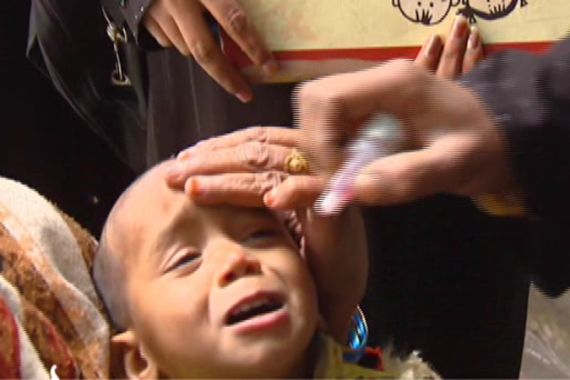India marks one year since last polio case
Health officials hail milestone in a country once home to more than half of world’s cases of crippling disease.

Health officials are hailing a polio breakthrough in India, once recognised as the global epicentre of the crippling disease, as the country marked one year since the last recorded case.
India, once home to half of all global cases of polio, on Friday completed one year since an 18-month-old girl in West Bengal was diagnosed with the disease.
The breakthrough could see India removed from a list of nations where polio is still endemic by the World Health Organisation (WHO) in the next month.
With Niger and Egypt taken off that list in recent years, India’s removal would see the list of nations with indigenous polio reduced to just three: Afghanistan, Nigeria, and Pakistan.
| Polio Eradication |
|
In 1988 over 350,000 people were paralysed by Polio annually. Now, cases have reduced over 99 per cent.
Information compiled by the World Health Organisation. |
“What India has achieved is reaching a first milestone in a very important process,” Lieven Desomer, head of the polio unit at United Nations children’s agency UNICEF in India, told the AFP news agency.
In a statement, Ghulam Nabi Azad, India’s health minister, said: “We are excited and hopeful, at the same time, vigilant and alert”.
Part of that alertness is a vast effort of 2.3 million vaccinators across the country to deliver 900 million doses of vaccine in the year since the West Bengal case.
In the Uttar Pradesh district of Moradab, once home to the highest number of polio cases in the nation, door-to-door vaccination teams have treated up to one million children per month.
In an interview with Al Jazeera, the World Health Organisation’s Bruce Aylward said India’s efforts showed “an incredible amount of accountability [and] real innovations in reaching children where nothing else could get to them”.
Part of these new tactics and innovations was an effort to reach poor children in railways and on the streets. “Remotes areas were huge havens of disease, but we persisted,” Sona Bari, a spokesperson for the Global Polio Eradication Initiative, told Al Jazeera. “Wherever there were no facilities, we just had people camping on the floor.”
According to WHO estimates, the Indian government dedicated two billion dollars to polio eradictation over the last decade and a half. “It was almost completely self-funded,” Bari said. “India has shown that it can be done, despite extremely difficult circumstances.”
Applying the same lessons
India’s falling number of polio cases is part of a global decline through the efforts of national governments, UN agencies and private donors that WHO says has decreased global cases by 99 per cent since 1988. Low income countries who eradicate polio by 2035 will save between $40bn and 50bn, according to the WHO’s latest economic analysis.
The advance in a nation where polio had been thought endemic, has raised hopes that polio will join smallpox as the second disease to have been successfully eradicated globally.
“India’s success (with polio) is arguably its greatest public health achievement,” said Margaret Chan, the WHO’s director-general.
With India’s success as a model, the last two parts of the world where polio is still an active threat, Northern Nigeria and neighbouring Pakistan, must begin “applying the same lessons and more” as a key to eradicating the virus globally said Aylward.
India will only be deemed to have eradicated the disease if it stays polio-free for another two years.
 There are three strains of wild polio virus; in 1999 Type 2 was eradicated.
There are three strains of wild polio virus; in 1999 Type 2 was eradicated.